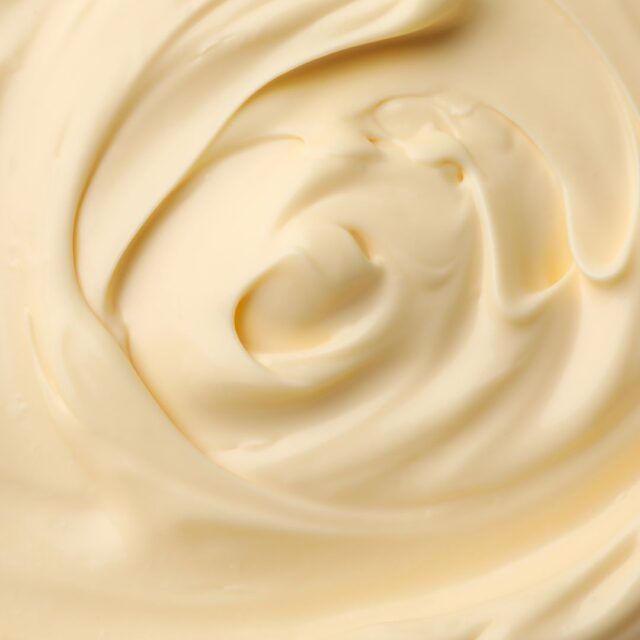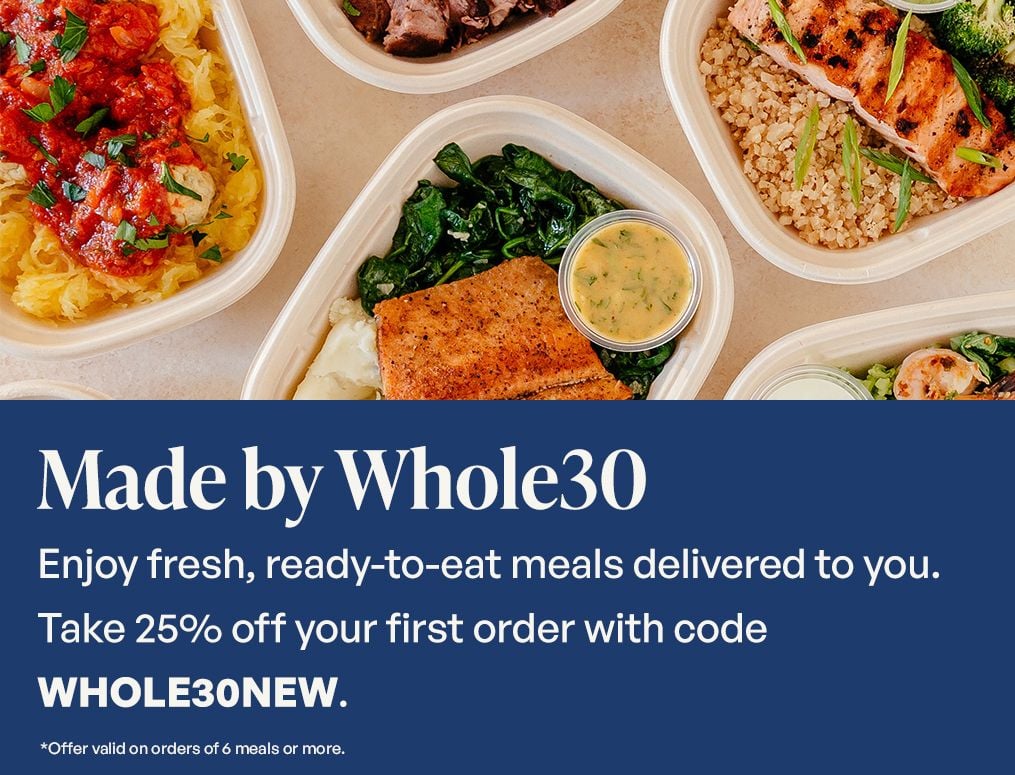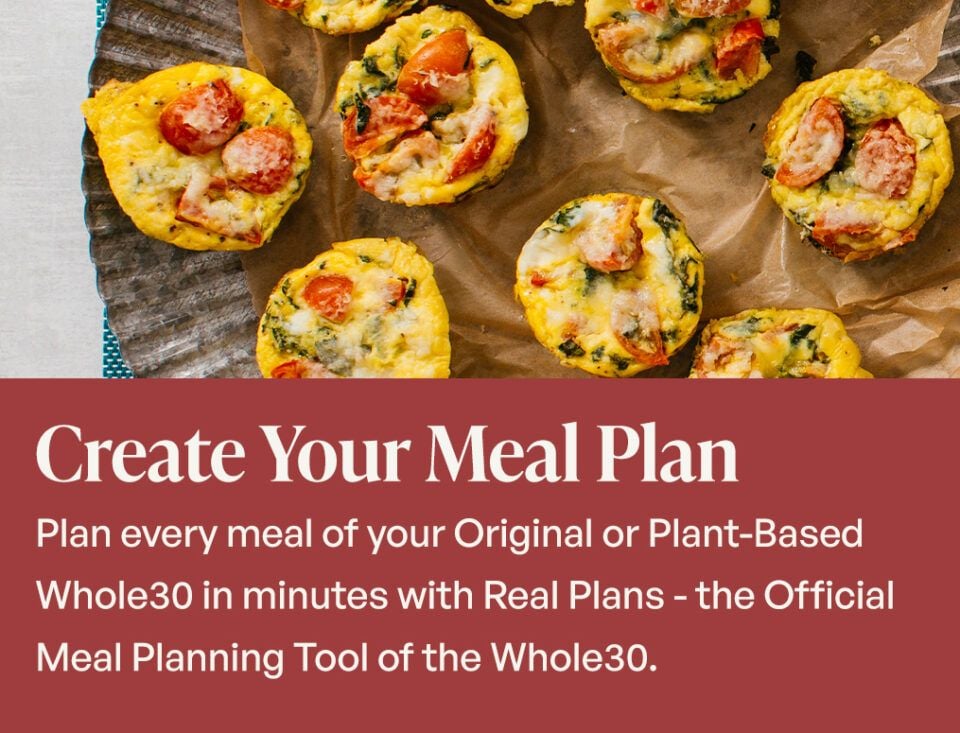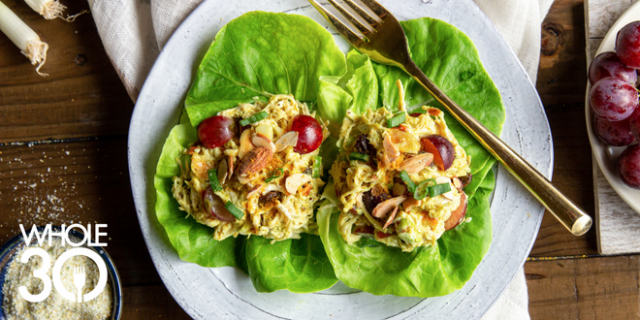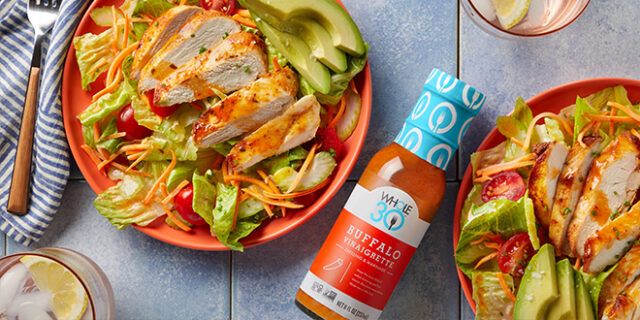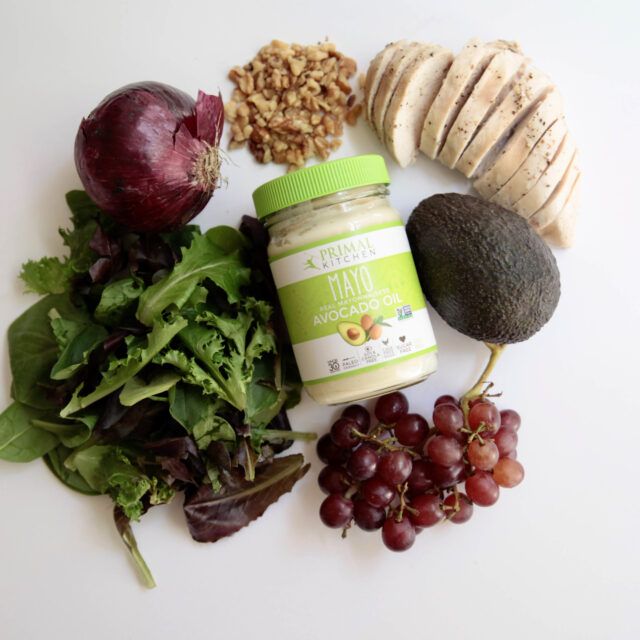By Melissa Urban, who always hated mayo until she started making it herself
I was talking to a Whole30’er the other day who mentioned she had never made homemade mayo. The only thing I could think to say was, “WHAT.” It made me sad, because you’re not really living on the Whole30 until you’ve made your own batch of mayonnaise.
For those of you who have experienced the creamy, dreamy goodness that is homemade mayo, you know exactly what I’m talking about. It’s light, it’s fluffy, and when you’re done mixing up a batch, you probably lick the beater just like me. The flavor is so very different than store-bought mayo. It’s more alive, more richly nuanced, less heavy, and way less gloopy. Once you’ve tried it, you’ll never go back.
But making your own mayo is one of those things that sounds so amazingly foodie—something that requires a culinary degree, special utensils, and a subscription to Epicurious. However, nothing could be further from the truth. Making your own mayo is simple—five ingredients, five minutes, and one basic kitchen implement is all it takes.
However, not all mayo recipes are created equal, and along the way, I’ve learned that some mayo-making techniques work better than others. So today, we’re sharing our definitive guide to making your own mayonnaise—the ingredients, the kitchen tools, and a few different ways you can use the finished product in your Whole30 meals.
Why make your own mayo?
Because ingredients. Need we say more?
Okay, in case we do, there are several ingredients in a lot of store-bought mayos that will rule it out for the Whole30—usually soybean oil and some form of sugar. Don’t be fooled by “healthy” labeling, either… even some “olive oil” mayos contain far more vegetable oil than olive oil.
Our favorite recipe was created by Melissa Joulwan (of Well Fed fame) for our book, It Starts With Food. However, over the years we’ve made a few tweaks, which we think help prevent mayo “fails” (when your mixture doesn’t emulsify*).
*An emulsion is a mixture of two liquids that would ordinarily not mix together, like eggs and oil. By slowly whisking the oil into the eggs, you create an end product that is thicker than the two original liquids.
Homemade mayo: the basic recipe
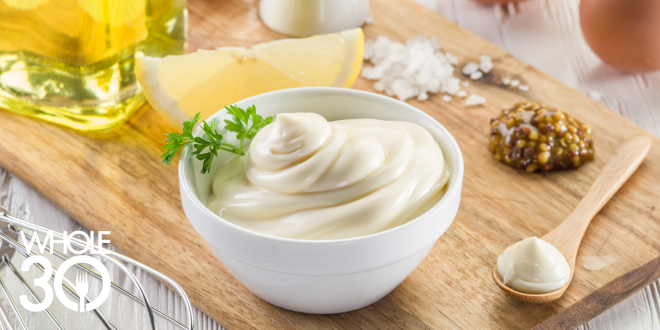
Ingredients:
- 1-1/4 cup of light olive oil, divided
- 1 egg
- 1/2 teaspoon mustard powder
- 1/2 teaspoon salt
- 1/2 to 1 lemon, juiced
Instructions:
Place the egg, 1/4 cup of olive oil, mustard powder, and salt in a mixing bowl, blender, or food processor. Mix thoroughly.
While the food processor or blender is running (or while mixing in a bowl with a stick blender), slowly drizzle in the remaining cup of olive oil.
After you’ve added all the oil and the mixture has emulsified, add lemon juice to taste, stirring gently with a spoon to incorporate.
Ingredient tips and tricks
The mustard powder, salt, and lemon juice don’t really matter, but the oil choice does.
Choose a light-tasting, light-colored oil.
First, make sure you use light olive oil, not extra virgin. (The EVOO tastes way too heavy.) You can also use a high-oleic safflower or sunflower oil, or avocado oil. The seeds used to make these oils have been bred to contain more healthy monounsaturated fats and less polyunsaturated fats, making their nutrition profile almost identical to olive oil. (Note, this is not the same as genetically modifying the seeds—these are not GMO products.) The flavor of all three of these oils is very mild, making it ideal for mayonnaise.
Bring it all to room temperature.
All of your ingredients need to be at room temperature. This is really important for the emulsification process. It’s usually not an issue for the oils or the spices—these are generally left in the pantry. Keep one lemon on the counter at all times, because warming up a lemon from the fridge takes a few hours. To quickly warm your egg, place in a cup of hot water for about three minutes—easy. (If planning ahead, you can also leave your egg out on the counter overnight. Yep, you can really do that.)
Preparation tips and tricks
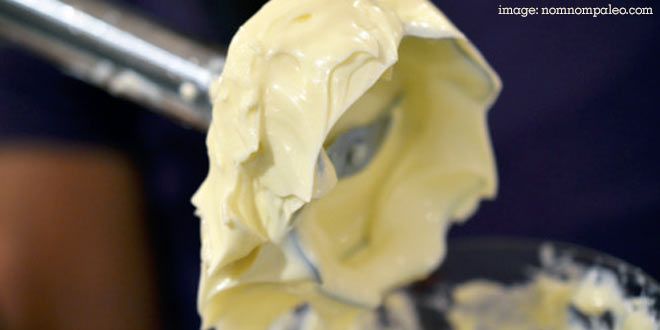
Listen to me right now: don’t bother busting out a 17-piece food processor just to make mayo. We swear by our stick blender for this recipe (among other things). They’re cordless, far easier to clean up than a blender or food processor, and relatively inexpensive. This Cuisinart is our favorite, at only $49.
Also, please don’t try to whisk mayo by hand. I know some recipes say you can do this. Scientific studies (in our house) have proven this is not humanly possible, and will probably give you a newly discovered inflammatory condition called Mayo Elbow. Don’t even bother. You’re welcome.
The slower you pour, the thicker the mayo.
To get started, you can dump the initial ingredients (the 1/4 cup of oil, egg, mustard powder, and salt) into a bowl or processor and just mix—you don’t have to be careful with the first part. When you get to the “slowly drizzle” part, though, take it seriously. Pour the remaining cup of oil in too fast and you’re left with a soupy, runny mess. The emulsion comes together best when you pour as thin a stream into the bowl as possible. I use a Pyrex spouted measuring cup to make pouring easier, but you can also use a tip from our friend Michelle at Nom Nom Paleo and buy an empty ketchup dispenser to slowly squirt a thin stream of oil into the bowl.
Pour. Slowly. So slowly you start to bore yourself. The slower you pour, the thicker your mayo. If you’re using a stick blender, use a stainless steel mixing bowl with a non-skid bottom so you can pour with one hand and mix with the other. (Or place your bowl on a silicone trivet so it stays put.) Stay away from copper or aluminum bowls here—the lemon juice can react with the metal and impart a metallic taste into your mayo.
Save the lemon juice for the very end.
Finally, add your lemon juice as the last step, after your mayo has thickened up. We have no scientific evidence to support this, but our theory is that the acid in the lemon juice can mess with the emulsification process. We had far more mayo fails when we added the lemon juice first—but since leaving it until the end, zero problems. We like our mayo really lemon-y, but the more juice you add, the thinner the mixture will become. You can always err on the lighter side and add just a tablespoon now, then add more if a recipe for tartar sauce or ranch dressing calls for it.
If you have a mayo fail…
Generally, fails happen because (a) some ingredients were cold instead of room temperature, or (b) you poured the oil too quickly. If you get all the way through the process and your mayo fails to emulsify, all is not lost. Just use that batch for salad dressings, where it’s less important that the mayo be thick and creamy. The flavor is the same, and you can shake it up before pouring to create a temporary emulsion.
Favorite mayo-based recipes
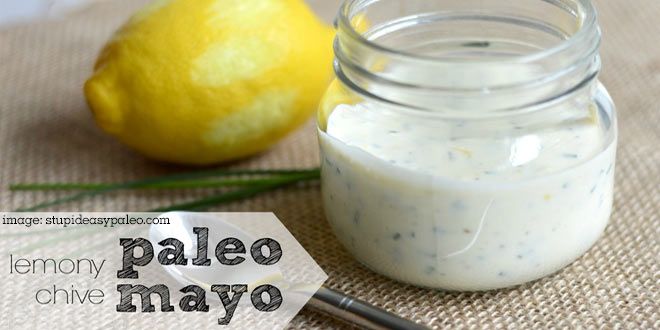
Aside from using homemade mayo the way anyone uses mayo (like in a chicken or tuna salad), you can also turn it into any number of dressings and sauces. There are also a million different ways to customize the flavor of your mayo for specialty uses. Here are a few of our favorite recipes.
Lemony-Chive Mayo
Delicious drizzled over salmon or roasted vegetables. From Steph Gaudreau.
- 1/2 cup compatible mayo
- 2 tablespoons chopped chives
- zest of 1 lemon
- black pepper
Put 1/2 cup of the mayo into a bowl. Use a microplane grater to zest the (washed) lemon, and add the zest to the bowl. Add the chopped chives. Stir thoroughly to combine. Add cracked black pepper to taste (optional).
Basil Garlic Mayo
Top steak, chicken, or fish, or toss with roasted sweet potatoes. Inspired by Epicurious.com.
- 1 cup finely chopped fresh basil
- 1 garlic clove, minced
- 1/4 teaspoon salt
- 1/8 teaspoon cayenne
- 3/4 cup compatible mayo
Place all ingredients in a bowl and mix until blended. Store covered in the refrigerator.
Ranch Dressing
You’ll never miss the buttermilk; makes about ½ cup. From Well Fed: Paleo Recipes for People Who Love to Eat.
- 1 clove garlic, minced
- 1/4 tsp paprika
- 1/4 cup fresh parsley leaves, minced
- 1 tbsp dried chives
- 1/2 cup compatible mayo
- 1 tsp lemon juice
- salt and black pepper
In a small bowl, mix the garlic, paprika, parsley, chives, and mayo with a fork. Drizzle in the lemon juice while continuing to mix, then taste and season with salt and pepper. If your dressing is too thick, add either lemon juice or water — 1/4 teaspoon at a time — until it’s the right consistency.
Caesar Dressing
Great on heartier salads; makes about 1/2 cup. Inspired by Primal Palate.
- 1 clove garlic, minced
- 1 lemon, juiced
- 1 tsp black pepper
- 1/2 tube anchovy paste (about 1 ounce)
- 1/2 cup compatible Mayo
- 1 tbsp Dijon or spicy brown mustard*
- salt and black pepper
Place all ingredients in a bowl and mix until blended. Store covered in the refrigerator. *If you are on the Whole30, read your mustard labels! Many Dijons contain white wine, which rules them out for the program.
Tartar Sauce
Makes everyday fish taste special; makes about 1/2 cup. From It Starts With Food.
- 1/2 cup compatible mayo
- 1 tbsp minced cornichons or dill pickle
- 2 tbsp fresh parsley leaves, minced
- 2 tsp minced capers
- 2 tsp minced chives (fresh)
- 1/2 tbsp lemon juice
- 1 tsp pickle juice
- salt and ground black pepper
Place all ingredients in a bowl and mix with a spatula until blended. Allow the flavors to meld for 30 minutes before serving. Store covered in the refrigerator.
Creamy Italian Dressing
Makes enough for two side salads or one entree-sized salad. From Melissa Joulwan.
- 2 tbsp homemade mayo
- 1 tbsp vinegar: balsamic, wine, or cider (I like pomegranate balsamic!)
- 1 clove garlic, crushed
- 1/8 tsp Italian herb blend (or pick one: dried oregano, rosemary, or basil)
- salt and pepper, to taste
Crush the dried herbs with your fingers, then add to mayo, along with garlic. Blend well with a fork. Mix in the vinegar, then taste and season with salt and pepper. If your dressing is too thick, add either vinegar or water – a 1/4 teaspoon at a time – until it’s the right consistency. Keep in mind that it will get slightly more liquidy as you toss it with your salad ingredients.
Tonnato Sauce
The perfect veggie dip, or great on chicken breasts. From Nom Nom Paleo.
- 1 (7-oz) can tuna packed in olive oil or water, drained
- 5 anchovies packed in olive oil, drained
- 2 tbsp capers, drained
- 3 tbsp lemon juice
- 1/2 cup extra virgin olive oil
- 1/2 cup homemade mayonnaise
- Kosher salt
- Freshly ground black pepper
Dump all the ingredients in a blender and blitz until smooth and creamy. Done.
Go make mayo right now.
Are you feeling confident and inspired by this informative mayo “how-to?” We figured all you needed was a little more guidance. Adding homemade mayo to your Whole30 opens you up to a whole new world of dressings, sauces, and flavor profiles, so go forth and mayo! (And be sure to lick the beater.)
Ingredients
- 1.25 cup light olive oil divided
- 1 egg
- 1/2 tsp mustard powder
- 1/2 tsp salt
- 1/2 lemon, juice of add more to taste
Equipment
- 1 blender, emulsion blender, or food processor
Instructions
- PLACE the egg, 1/4 cup of olive oil, mustard powder, and salt in a mixing bowl, blender, or food processor. Mix thoroughly.
- WHILE the food processor or blender is running (or while mixing in a bowl with a stick blender), slowly drizzle in the remaining cup of olive oil.
- AFTER you’ve added all the oil and the mixture has emulsified, add lemon juice to taste, stirring gently with a spoon to incorporate.
